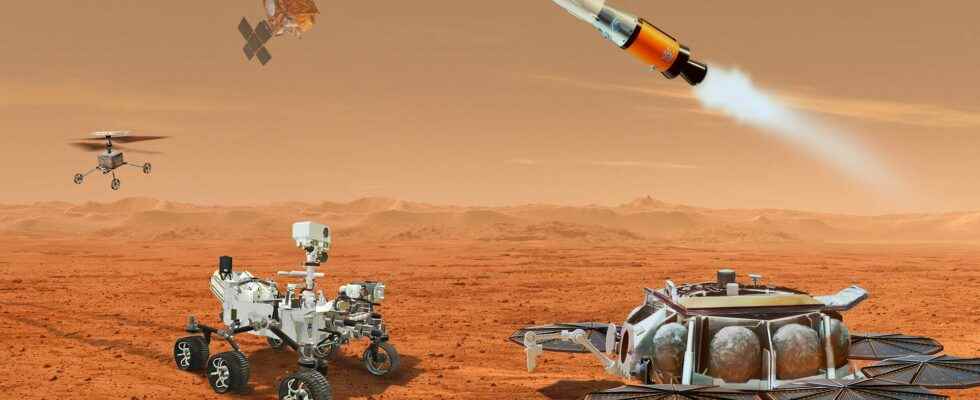New scenario for the Mars sample return mission being developed by the European Space Agency and NASA. The two agencies presented yesterday a new architecture of the mission in order to reduce its complexity, and what changes in the scenario of the operations on Mars. The return date of the Martian samples is unchanged, in 2033.
You will also be interested
[EN VIDÉO] An inflatable Mars sample catcher To recover a container of samples freshly taken from the Red Planet in Mars orbit, Thales Alenia Space has designed this inflatable gripper. We see it here opening (the movement is accelerated ten times) then closing on the container (the ball) and locking it up. This device could also be used to catch space debris. © Thales Alenia Space
Since touching down in Jezero Crater on February 18, 2021, the Perseverance rover collected eleven samples of carrots of rock and an atmospheric sample. While the rover of the Nasa continues its collection, on Earth, the mission that will bring them back to Earth continues.
Yesterday, NASA and ESA announced a new mission architecture and a new scenario on Mars for the return of these samples. Thomas Zurbuchen, associate administrator of the US Space Agency’s Science Missions Directorate, said that ” significant and beneficial changes have been made to the program, which can be directly attributed to the recent successes of Perseverance at Jezero and the amazing performance of [l’] martian helicopter “.
Concretely, NASA wants to use Perseverance to bring the samples to the MAV (Mars Ascent Vehicle), the rocket which will be used to send them into Mars orbit. The European Space Agency’s Fetch rover, built by Airbus, which was to retrieve the samples and bring them to the MAV is therefore abandoned, as is the lander which was to bring it to Mars. Depending on the Perseverance rover alone to transport the samples is therefore a huge technological gamble.
Two helicopters in support of Perseverance
The most surprising announcement is NASA’s decision to use two helicopters for this mission! Their design was inspired by that ofIngenuity who made 29 flights to Mars and survived more than a year beyond his duration initially planned life. NASA did not detail the role and mode of operation of these two flying machines, explaining only that they will be used as a backup to recover the samples if Perseverance did not manage to bring them to the MAV. It’s still a mission robotics very complex to implement.
The platform that will bring the MAV and the two helicopters, the Sample Retrieval Lander, will be equipped with a robotic arm provided by the European Space Agency for the recovery and transfer of the samples in the container and the contents in the MAV. This arm will also have a backup function. If Perseverance and the two helicopters cannot bring the samples to the MAV, this European arm will be able to carry out a relief collection.
The launch dates of capture and return satellite to Earthprovided by the European Space Agency and the Sample Retrieval Landerare provided for respectively infall 2027 and summer 2028. The samples are expected to arrive on Earth in 2033, two years after those from the MSR Chinese mission.
Bringing samples from Mars back to Earth would allow scientists around the world to examine the specimens using sophisticated instruments far too large and complex to send to Mars. Above all, this would allow future generations to study them at more or less regular intervals as analytical techniques progress, just as is done with lunar samples from the Apollo missions.
A desire to escape for the summer?
To celebrate the holidays as it should be, discover the Mag Futura at the preferential price of €15 instead of €19, i.e. a reduction of 20% !
On the program of this issue: a dive into the heart of 4 scientific themes that will mark 2022, from the Earth to the Moon:
- What mysteries does the Moon still hide from us?
- Will we soon be able to cure everything thanks to genes?
- How to feed the world without destroying it?
- Can artificial intelligence become truly intelligent?
What is Mag Futura?
- Our first paper journal of more than 200 pages to make science accessible to as many people as possible
- 4 major scientific questions for 2022, from the Earth to the Moon
- Home delivery*
*Delivery is made in France (excluding metropolitan France), Switzerland, Belgium.
Interested in what you just read?
